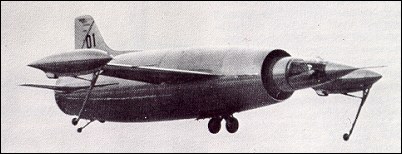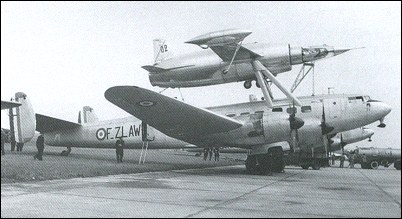 |
Leduc 0.211953 |  |
| RAM-JET RESEARCH AIRCRAFT | Virtual Aircraft Museum / France / Leduc |
 |
Rene Leduc in France had worked for many years on the development of a ramjet engine for aircraft propulsion. Known technically as an aero-thermo-dynamic-duct or athodyd, which has no major rotating components, a ramjet relies upon air being forced into an intake which is designed to ensure that the air loses kinetic energy but gains pressure energy as it passes through a diverging duct en route to a combustion chamber. There, burning fuel increases the total energy, causing the expanding gases to accelerate to atmosphere via an outlet venturi. Leduc's first success had come in 1935 with a small but practical engine developing 4kg of thrust. It was not until after the end of World War II that Leduc was able to continue his experiments, building first the Leduc 0.10 with a tubular double-skinned fuselage in which the inner shell contained the pilot's cockpit, surrounded by an outer shell which formed the inlet duct to the ramjet engine at the rear of the pilot's position. First tested as a glider in October 1947, the Leduc 0.10 was carried on struts above a Sud-Est SE.161 Languedoc 'motherplane' which released it at appropriate altitude. The first powered flight was made on 21 April 1949, the SE.161 accelerating the Leduc 0.10 to a speed of approximately 322km/h to achieve the right pressure conditions for the ramjet to ignite and sustain power. During the first flight, of 12 minutes duration, a speed of 680km/h was attained on half power. The aircraft was flown subsequently on half power at a speed of 805km/h. Two more examples were built, the first an identical 0.10, the other differing only by having two wingtip-mounted turbojet engines to accelerate the aircraft to the ignition speed of the ramjets. This last aircraft, designated 0.16, was first flown on 8 February 1951, but the turbojet engines were later removed. Development continued with two examples of the larger Leduc 0.21 of improved design, the first making its initial flight on 16 May 1953. These proved to be successful, demonstrating a maximum speed of Mach 0.87 and attaining an altitude of 20,000m. Development then began of the Leduc 0.22 Mach 2 interceptor which incorporated a SNECMA Atar turbojet within the athodyd to allow the aircraft to take off under its own power and then accelerate it to a speed at which the ramjet would ignite. This was not achieved with the 0.22, for although flown on turbojet power for the first time on 26 December 1956, and later making more than 30 test flights with the turbine engine, the ramjet was not tested. This resulted from withdrawal of government financial support, because of economic stringencies, and the project was abandoned.
|  All the World's Rotorcraft | |||||||||||
 |

|

